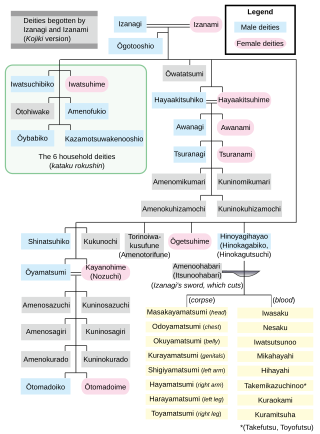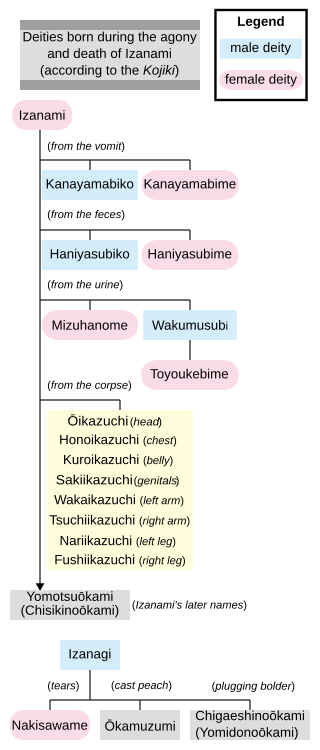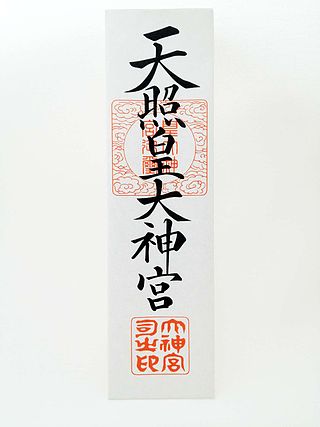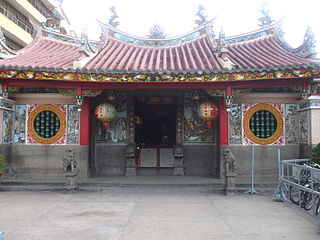Kami are the deities, divinities, spirits, mythological, spiritual, or natural phenomena that are venerated in the Shinto religion. They can be elements of the landscape, forces of nature, beings and the qualities that these beings express, and/or the spirits of venerated dead people. Many kami are considered the ancient ancestors of entire clans. Traditionally, great leaders like the Emperor could be or became kami.

In Japanese religion, Yahata formerly in Shinto and later commonly known as Hachiman is the syncretic divinity of archery and war, incorporating elements from both Shinto and Buddhism.

Arahitogami (現人神) is a Japanese word, meaning a kami who is a human being. It first appeared in the Nihon Shoki as the words of Yamato Takeru saying: "I am the son of an Arahitokami."

In Shinto and Buddhism in Japan, an ofuda or gofu (護符) is a talisman made out of various materials such as paper, wood, cloth or metal. Ofuda are commonly found in both Shinto shrines and Buddhist temples and are considered to be imbued with the power of the deities or Buddhist figures revered therein.

A Shinto shrine is a structure whose main purpose is to house ("enshrine") one or more kami, the deities of the Shinto religion.

Ōyama-tsumi or Ohoyama-tsumi, also Ōyama-tsumi-mi'oya-no-mikoto (大山祇御祖命), is a god of mountains, sea, and war in Japanese mythology. He is an elder brother of Amaterasu and Susanoo. His other names are Watashi-no-Ōkami (和多志大神) and Sakatoke (酒解神).
An ujigami is a guardian kami of a particular place in the Shinto religion of Japan. The ujigami was prayed to for a number of reasons, including protection from sickness, success in endeavors, and good harvests.
An Inari shrine is a type of Japanese shrine used to worship the kami Inari. Inari is a popular deity associated with foxes, rice, household wellbeing, business prosperity, and general prosperity. Inari shrines are typically constructed of white stucco walls with red-lacquered woodwork, and their entrances are marked by vermilion torii. Both Buddhist and Shinto Inari shrines are located throughout Japan.

Toyouke-hime is the goddess of agriculture, industry, food, clothing, and houses in the Shinto religion. Originally enshrined in the Tanba region of Japan, she was called to reside at Gekū, Ise Shrine, about 1,500 years ago at the age of Emperor Yūryaku to offer sacred food to Amaterasu Ōmikami, the Sun Goddess.
This is the glossary of Shinto, including major terms on the subject. Words followed by an asterisk (*) are illustrated by an image in one of the photo galleries.

This is the glossary of Japanese Buddhism, including major terms the casual reader might find useful in understanding articles on the subject. Words followed by an asterisk (*) are illustrated by an image in one of the photo galleries. Within definitions, words set in boldface are defined elsewhere in the glossary.
Ubusunagami in Shinto are tutelary kami of one's birthplace.

In Japan, a chinjusha is a Shinto shrine which enshrines a tutelary kami; that is, a patron spirit that protects a given area, village, building or a Buddhist temple. The Imperial Palace has its own tutelary shrine dedicated to the 21 guardian gods of Ise Shrine. Tutelary shrines are usually very small, but there is a range in size, and the great Hiyoshi Taisha for example is Enryaku-ji's tutelary shrine. The tutelary shrine of a temple or the complex the two together form are sometimes called a temple-shrine. If a tutelary shrine is called chinju-dō, it is the tutelary shrine of a Buddhist temple. Even in that case, however, the shrine retains its distinctive architecture.

Takemikazuchi (建御雷/武甕槌) is a deity in Japanese mythology, considered a god of thunder and a sword god. He also competed in what is considered the first sumo wrestling match recorded in history.

Mizuhanome is a divinity of water in Japanese mythology. She was born from the urine of Izanami.

Himetataraisuzu-hime(媛蹈鞴五十鈴媛) is a Japanese goddess, a mythological figure in the Nihon Shoki, the first empress of Japan, and the first wife of Emperor Jimmu.

Gion worship is a Shinto cult. Originally it revolved solely around Gozu Tenno, but during the Separation of Shinto and Buddhism of the Meiji era the government mandated it shift to revolving around Susanoo.

Jingū Taima is an ōnusa wrapped in clean Ise washi and issued by the Ise Grand Shrine. They are a form of ofuda. The Association of Shinto Shrines recommends every household have at least three Ofuda in their Kamidana, a Jingu Taima, an Ujigami ofuda, and another deity one personally chooses.
Present life is a religious term meaning the current life someone is living in right now. It is distinct from the next life or past life in religions which believe in reincarnation or the Everlasting world in Shinto, or the afterlife in Abrahamic religions.

Miao (廟/庙) are buildings in traditional East Asian religions enshrining gods, myths or legends, sages of past dynasties, and famous historical figures. They are a kind of Chinese temple architecture and contrast with Ci Shrines which enshrine ancestors and people instead of deities.


















